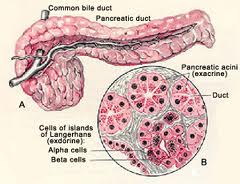Currently I am extremely busy on placement within the community, and am working alongside a Home-Based Treatment Team (formerly called the Crisis Team). Aside from this, I am also revising for a forthcoming exam which takes place towards the end of September. At the moment I am revising diabetes, and in order to help me clarify my learning, I thought that I would try to rewrite some of the main facts that I have learnt.
The Pancreas and Diabetes
The pancreas is a 90% exocrine and 10% endocrine gland. As an exocrine, it produces secretions which are released into ducts, and also produces digestive enzymes which are passed into the pancreatic duct and then into the duodenum. As an endocrine, the pancreas produces the two hormones glucagon and insulin.
Glucagon is made in the Alpha cells, and promotes the production of glucose through utilising stored glycogen – a process called GLYCOGENOLYSIS. Additionally, glucagon can also make glucose from fats and proteins, and does this through GLUCONEOGENESIS.
Insulin is made in the Beta cells in the Islets of Langerhans, and in conjunction with insulin receptors, it allows cells to uptake glucose in order to obtain essential energy. It does this through making glycogen – GLYCOGENESIS. Insulin also contributes to the maintenance of homeostatic blood glucose levels.
Other hormones in the body can effect blood glucose levels. The growth hormone (Somatotrophin) can elevate blood glucose levels, as well as Adrenocorticotrophin – producing Cortisol in stressful situations; while the adrenal medulla produces adrenaline and noradrenaline in stressed individuals, once again causing blood glucose levels to rise.
Diabetes occurs in two main types: Type 1 and Type 2. Type 1 is usually an autoimmune disorder which causes the beta cells to stop producing insulin. It typically affects young people, and will need to be treated with insulin injections and dietary monitoring. In Type 2 diabetes the pancreas is still making insulin, but is not working so efficiently. The insulin receptors, which allow the insulin to get into the cells, are much reduced. Type 2 diabetes typically affects middle aged overweight people, and will need to be treated through adopting a healthy diet, some weight loss and exercise.
Symptoms of Type 1 Diabetes –
Hyperglycaemia
These are increased thirst (polydipsia), increased urination (polyuria), glucose in urine (glycosuria), increased appetite (polyphagia) and loss of weight. Within the body, the cells are unable to utilise glucose for energy, and glucose builds up in the bloodstream causing hyperglycaemia. The kidneys filter the blood and try to reabsorb the glucose, but there is just too much for them to cope with. The body’s cells are still trying to obtain glucose, so they break down stored glycogen and turn it into glucose – GLYCOGENESIS, as well as turning fats and proteins into glucose – GLUCONEOGENESIS. As the glucose is unable to be utilised, the blood glucose levels become dangerously high and the person will start to breath rapidly (Kussmaul breathing) in an attempt to get rid of accumulating carbon dioxide. A smell of ketones will be evident in their breath, as these will have been produced by the glucagon making glucose from the fat cells.
Hyperglycaemia can be reversed by taking insulin, but where the blood glucose levels are too high, hospitalisation will urgently be needed as Diabetic Keto Acidosis (DKA) will be present. In DKA the blood turns acidic, and if untreated the patient will die by falling into a coma. An individual with DKA will have nausea, vomiting or diarrhoea. In order to counteract the dehydration and acidity, IV fluids will need to be administered, plus a sliding scale of insulin. The body’s electrolytes will also be imbalanced, and potassium will commonly need to be given. In order to regain homeostasis, regular checking of blood glucose levels and electrolytes will be essential.
Hypoglycaemia
These symptoms present as sweating, confusion and disorientation, and being pale in appearance. Slurred speech and drowsiness may occur, and the danger is that a hypoglycaemic individual may be perceived as being drunk. Hypoglycaemia will occur as a result of taking too much insulin, or going without food for too long. As long as the individual is conscious, it can easily be rectified by drinking a carton of orange juice, a full sugar cola or consuming some glucose sweets (although liquids are more fast acting). An unconscious patient however, needs to get to hospital urgently, as they can start to get convulsions, go into a coma and brain damage can occur.
Symptoms of Type 2 Diabetes
These can be tiredness, lethargy, blurred vision, repeated fungal infections (thrush), getting up in the night to urinate (nocturia), obesity and hyperglycaemia. People with Type 2 diabetes do not commonly experience hypoglycaemia.
If people with either type of diabetes do not look after themselves, the long term effects can be devastating and include: loss of nerves in the fingers and toes (neuropathy); foot sores and wounds, which may lead to septicaemia and eventual amputation of limbs; damage to the eyes, which may result in diabetic retinopathy, glaucoma, cataracts or eventual blindness; kidney damage; heart disease, and even brain damage.
We only have one body, so clearly we need to look after ourselves, whether we have diabetes or not. A healthy diet and lifestyle is one of the best ways to do this.

